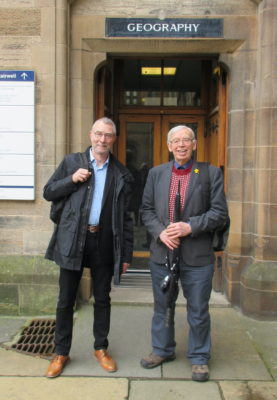It is with great sadness I report the death of my mentor and professor, Gordon Petrie, on 4 April 2020, in Glasgow, Scotland. He was 89. Full obituaries will appear in some of the British geospatial journals, but a few words here provide a cameo.
Gordon is best known to readers of LIDAR Magazine for his extensive contributions to both editions of Topographic Laser Ranging and Scanning, the award-winning textbook edited by Jie Shan and Charles Toth. His short article, ‘The spelling and useage of “lidar”’ in LIDAR Magazine, volume 8, issue 3 (May/June 2018), pages 6-8, was in many ways archetypical of this remarkable man: articulate; packed with detail; indicative of an incredible, encyclopedic memory; didactic; authoritative, yet gently and persuasively so. At the time, he provided me with the following words about himself [I’ve made the obvious changes to the past tense]:
“Gordon Petrie was emeritus professor of topographic science at the University of Glasgow in Scotland. He joined the University in 1958 after a short career as a professional land surveyor with the U.K. Directorate of Overseas Surveys, working mainly in Yemen. He taught and researched in photogrammetry, remote sensing and surveying in Glasgow until his retirement, but continued to write and research extensively, for example on the history of mapping and on photogrammetric and laser instrumentation. Gordon had strong connections with the U.S.A. through his frequent participation in academic and professional meetings and his spells as visiting professor at the University of Georgia (twice) and Miami University of Ohio. He received the Fairchild Photogrammetric Award from ASPRS in 2008 and was the recipient of the President’s Medal by the U.K. Photogrammetric Society and the Bartholomew Globe by the Royal Scottish Geographical Society.”

Managing editor Stewart Walker with Emeritus Professor Gordon Petrie at the door of the Department of Geography (now School of Geographical & Earth Sciences), during a visit to the University of Glasgow in March 2018
In addition to providing a rigorous grounding in land surveying and photogrammetry, Gordon guided numerous undergraduates to seek higher degrees and employment all over the world, opening the eyes of young students to opportunities almost beyond their imaginations. In my case, not long after my 21st birthday, I was on an Air Canada DC8 to start a graduate degree at the University of New Brunswick. He had judged me suitable, after tirelessly correcting my essays and exercises in his purple pen, not just technical errors but shortcomings in spelling and grammar too! His patience and depth of knowledge will never be forgotten. Without his counsel, many lives would have followed less geographically or intellectually adventurous paths.
Gordon continued to be productive almost until the end. Less than a month before his death, he wrote to Stuart Granshaw, editor of The Photogrammetric Record, about the projects on his desk: “I am still quite heavily engaged in a number of topics, including further investigations into the historic aerial photography of Ethiopia; more delving into the Barr & Stroud Archive; contributing to a new study of the secret pre-World-War-II spy flights over Germany; and contributing another chapter on “Mobile Mapping” to the Routledge Handbook of Geospatial Technologies. All good fun and it keeps me interested and mentally active as well as busy.” Yes, indeed.
In the current circumstances, a large funeral was not possible, but a celebration of Gordon’s life is being planned, to take place in 2021 in Glasgow. LIDAR Magazine hopes to attend.